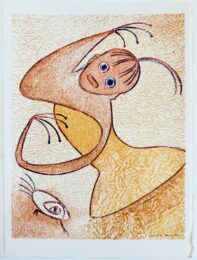

1891 -1976
Max Ernst was a prominent German artist known for his contributions to the Dada and Surrealist movements. While he is primarily recognized for his paintings and sculptures, Ernst also made significant contributions to the field of printmaking. Through his innovative techniques and imaginative approach, Ernst transformed the medium, pushing its boundaries and opening up new possibilities.
Ernst’s exploration of printmaking began in the early 1920s when he started experimenting with various techniques such as etching, lithography, and collage. He sought to liberate the print from its traditional constraints and imbue it with his characteristic dreamlike and subversive imagery. Ernst often combined different techniques to create unique and visually striking compositions.
One of Ernst’s most notable contributions to printmaking was his invention of the “frottage” technique. Frottage involves placing a piece of paper over a textured surface and then rubbing it with a graphite or pencil, capturing the intricate patterns and textures. Ernst used this method to create a series of prints titled “Histoire naturelle” (Natural History), where he transformed mundane objects into fantastical creatures and landscapes. The frottage technique allowed Ernst to tap into the unconscious and draw out unexpected forms from the surface, revealing hidden worlds.
Another important printmaking technique employed by Ernst was “grattage.” In grattage, the artist scrapes or scratches the surface of the printing plate to create textured effects. Ernst utilized this technique to depict surreal and dreamlike landscapes, combining it with other methods such as etching and aquatint. The resulting prints, such as “The Temptation of Saint Anthony,” featured a harmonious fusion of organic and geometric elements, blurring the boundaries between reality and imagination.
Ernst’s printmaking practice was characterised by his fascination with automatism and chance. He embraced accidental marks and unplanned interventions, allowing the medium to guide his creative process. His prints often featured enigmatic and symbolic imagery, evoking a sense of mystery and introspection.
Throughout his career, Max Ernst produced an extensive body of prints that showcased his innovative approach to the medium. His contributions to printmaking expanded the artistic possibilities and influenced subsequent generations of artists. Today, his prints can be found in major art collections worldwide, serving as a testament to his lasting impact on the field.